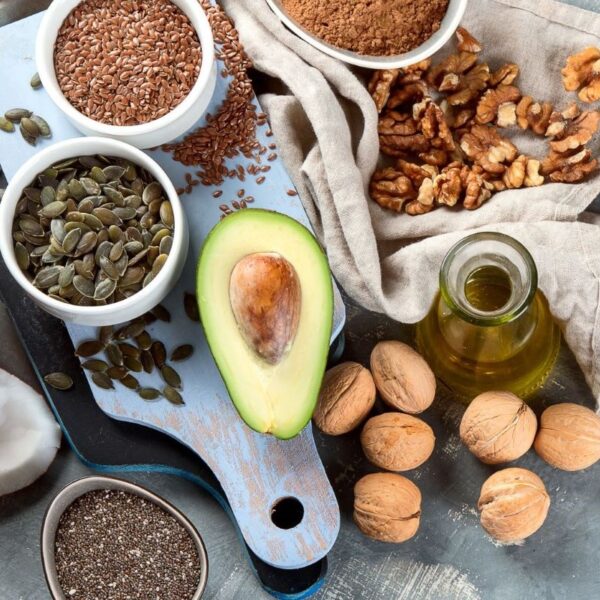Lecithins are a group of naturally occurring phospholipids. Due to their lipophilic and hydrophilic nature, lecithins have functional properties that are useful in the formulation of food products. Lecithins are also consumed as supplements for their health benefits.
What is Lecithin?
Lecithins are mixtures of glycerophospholipids, including phosphatidylcholine, phosphatidylethanolamine, phosphatidylinositol, phosphatidylserine, and phosphatidic acid. Phospholipids contain a hydrophilic (water-loving) head and a hydrophobic (water-repelling) tail.
Source: Wikipedia
How is Lecithin Produced?
Lecithin can be found in various natural sources, including soybeans, eggs, sunflower seeds, peanuts, canola, and cottonseed.
Lecithin can be extracted using three different methods, as described in the table below:
| Mechanical | – Lecithin can be extracted mechanically from sunflower oil without using solvents. This extraction method preserves sunflower lecithin’s natural nutrients, antioxidants, flavor, and aroma, making it a desirable method. – Degumming can be done with water, organic acids/anhydrides, or enzymes. Water degumming separates variable amounts of phosphatides ranging from 80-95%. Oils high in nonhydratable phosphatides may require pre-treatment with phosphoric acid. The gums are hydrated to the point that they form gels and precipitate from the oil. The centrifuged product is then dried and bleached. Over-drying causes dark-colored lecithin, whereas insufficient drying will produce a cloudy product. |
| Chemical | – Solvent extraction involves adding a suitable solvent, such as hexane or acetone, to the crushed or ground source material. The solvent will dissolve the lecithin and other lipids present in the material. – Separation can be done through filtration or centrifugation. |
| Enzymatic | – The enzymatic hydrolysis method uses proteases to break large molecular proteins into small molecular peptides, speed up the separation of lecithin and protein, and shorten the extraction process of lecithin to improve efficiency. – The enzymatic hydrolysis method involves a mild operating environment, enabling it to produce relatively high-quality proteins and lipids. To further improve the extraction efficiency, ultrasonic-assisted enzymatic extraction can be used. |
Use of Lecithin in the Food Industry
| Emulsifier | Forms a surface layer around the fat and water molecules to create a uniform phase |
| Stabilizer | Prevents the separation of fat and water molecules, helping to keep the mixture stable |
| Texturizing Agent | Makes the mixture more cohesive, improving the texture |
| Wetting Agent | Used to improve the wetting properties of powdered foods |
| Food Supplement | Rich source of essential fatty acids, antioxidants, and choline |
Applications in the Food Industry
| Function | Applications |
| Emulsifier | Breads, Cookies, Crackers, Cakes, Donuts, Pizza, Flatbreads, Tortillas, Confectionery, Dairy-Based Beverages, Protein Beverages, Juices, Ice Cream, Milk-Based Desserts, Vegan Meat and Dairy Products, Sauces, Fillings |
| Stabilizer | Breads, Cookies, Crackers, Cakes, Donuts, Pizza, Flatbreads, Tortillas, Confectionery, Dairy-Based Beverages, Protein Beverages, Juices, Ice Cream, Milk-Based Desserts, Vegan Meat and Dairy Products |
| Texturizing Agent | Vegan Meat and Dairy Products |
| Wetting Agent | Sauces, Fillings, Gravies |
| Viscosity Modifier | Confectionery, Dairy-Based Beverages, Protein Beverages, Juices |
Properties of Lecithin
| Physical Form | Liquid, powder, granules |
| Color | Nearly white when freshly made, but rapidly becomes yellow to brown with exposure to air |
| Odor | Odorless or slight nutlike odor; faint fatty odor |
| Taste | Bland |
| Storage Temperature & Conditions | 2-8°C |
| Melting Point | 236-237°C |
| Molar Mass | 757.56 g/mol |
| Density | 1.0305 at 24°C |
| Viscosity @ 25°C | ~20,000 cP varies |
| pH | 6.6 |
| Specific Gravity at 25°C | 1.03 -1.05 |
| HLB Value | 3-5 and more |
| Solubility | Insoluble in water. Soluble in chloroform, ether, and petroleum ether. Insoluble in acetone. |
| Claims (*Product Specific) | Non-GMO*, Natural*, Organic*, Soy-Free*, Allergen-Free* |
Typical Formulations
Cookie Dough
Here is an emulsifier formulation table for cookies made with lecithin, along with the % weight of the ingredients:
| Ingredient | % Composition |
| Outer Dough (First Dough) | |
| Shortening | 18.63 |
| Polyglycerol esters | 0.28 |
| Whole eggs | 1.02 |
| Baking soda | 0.51 |
| Sugar | 35.09 |
| Flour | 32.79 |
| Starch | 0.5 |
| Salt | 0.63 |
| Water | 8.79 |
| Molasses | 1.51 |
| Egg white solids | 0.25 |
| Inner Dough | |
| Shortening | 18.80 |
| Distilled monoglycerides | 0.66 |
| Polyglycerol esters | 0.14 |
| Diacetyl tartaric acid ester of fatty monoglycerides | 0.19 |
| Lecithin | 0.01-0.2 |
| HFCS | 30.82 |
| Whole egg | 2.01 |
| Baking soda | 0.51 |
| Sugar | 12.49 |
| Flour | 31.73 |
| Starch | 2.24 |
| Salt | 0.41 |
The emulsifier system provided texture, flavor, and appearance advantages in the cookies.
Source: Google Patents
Soy Based Frozen Dessert (Chocolate Mint Flavored)
Here is an example formulation table of soy-based frozen dessert made with lecithin along with the % weight of the ingredients:
| Ingredient | % Composition |
| Soy milk concentrate (18% solids) | 43.8 |
| Fructose | 12.0 |
| Water | 25.8 |
| Supplemental oils (primrose/flaxseed) | 5.0 |
| Sucrose | 3.9 |
| Rice syrup | 2.5 |
| Cocoa | 2.4 |
| Micronutrients | 2.34 |
| Lecithin | 0.3 |
| Citric acid | 0.3 |
| Prebiotic | 0.6 |
| Stabilizer (gums/hydrocolloids) | 1.0 |
Lecithin improves the dispersal of fat, controls the accumulation of fat globules after homogenization, aids in the inclusion of air during freezing, increases resistance to melting, and imparts dryness to the extruded product.
Source: Justia Patents
Flavored Milk Drink
Here is an example formulation table of flavored milk drink made with lecithin along with the weight of the ingredients:
| Ingredient | Composition |
| Fresh milk | 300 kg |
| Sugar | 50 kg |
| Albumen sugar | 1 kg |
| Stabilizer combination for dairy food | 5 kg |
| Citric acid mono | 3 kg |
| Lactic acid | 1.5 kg |
| Natrium calcium | 0.3 kg |
| Lecithin | 1 kg |
| Milk flavor | 0.2 kg |
| Grapefruit essence | 0.3 kg |
| Mangosteen essence | 0.2 kg |
| Water | Make up to 15-tonne |
Source: Google Patents
Sugar-Free Chewing Gum
Here is an example formulation table of chewing gum drink made with lecithin along with the weight of the ingredients:
| Ingredient | % Composition |
| Gum base | 32-42 |
| Lecithin | 0.25-0.75 |
| Acetylated monoglycerides | 0.5-0.6 |
| Glycerin | 2.0-3.5 |
| Maltitol | 35-45 |
| Sorbitol powder | 5.0-15 |
| Flavor | 0.5-4.0 |
| Acid | 0-2.0 |
| Color | 0-0.5 |
| High-intensity sweetener (aspartame, neotame, sucralose, ace-K) | 0.1-5.0 |
Source: EPO
Lecithin Formulation Considerations
| Physical Forms | Powder, liquid |
| Stability | Stable but sensitive to light, heat, humidity, and gas. Incompatible with strong oxidants. |
| Dosage | 0.05 to 2.0 or more, depending on the application |
| Interaction with Other Components | Salt content above 2% may affect lecithin functionality. Lecithin is most effective in formulas with a pH above 4. Incompatible with strong antioxidants. |
Effect on Properties of Food
| Consistency | – Lecithin can decrease mixing times and improve results when combining dissimilar ingredients in a formulation. – Lecithin is first dispersed in the oil phase when used in oil-in-water (o/w) or water-in-oil (w/o) emulsions. Less lecithin is required (~1-5% of oil weight) in w/o emulsions than o/w emulsions (~5-10% of oil weight).In bread baking, lecithin increases volume and improves shelf life. It can also reduce shortening requirements. |
| Wettability | – Lecithin provides rapid and complete wetting of powders into aqueous systems. When using low-fat powders, lecithin products with a lower HLB value must be selected to retard the wetting rate. Hydrophilic (higher HLB) lecithin products promote the wetting of fatty powders. – Smaller particles with larger surface areas may require up to 2% lecithin, whereas improved wetting properties of larger particles can be accomplished at up to 0.25%. |
Comparison of Lecithin Sources
There are several different sources of lecithin commonly used in food production. Lecithin is extracted from these various sources to serve specific purposes based on the application. Soy lecithin, in particular, is the most widely used source due to its abundance and versatility. However, alternatively-sourced lecithins, such as sunflower and egg lecithin, are also gaining popularity. Here is a comparison of the properties of soy lecithin, sunflower lecithin, and egg lecithin.
| Property | Soy Lecithin | Sunflower Lecithin | Egg Lecithin |
| Availability | Abundantly available | Widely available | Widely available |
| Method of extraction | Mechanical and chemical extraction | Mechanical extraction is preferred for retaining natural components. | Chemical method |
| Purity | Purity ranges from 70-98%. | Purity ranges from 70-98%. | Highly purified mixture of phospholipids, devoid of triglycerides, cholesterol, or proteins |
| Taste | Can have a characteristic taste of soy | Has a neutral taste | Can have a distinct taste of egg |
| Phosphatidyl choline content | Almost half phosphatidyl choline content compared to egg lecithin | Higher choline content than soy lecithin | Higher phosphatidyl content than sunflower and soy lecithin |
| Cost-Effectiveness | Soy seeds have a comparatively greater amount of lecithin than sunflower seeds. | Sunflower seeds have comparatively less lecithin content than soy. | Costlier |
| Allergens & Health Implications | A considerable amount of soy protein in any product can trigger allergic reactions. | Allergen-free alternative to soy and egg lecithin | People sensitive to ovalbumin, the primary allergen in eggs, should not be at risk of allergy through egg lecithin, provided there is no cross-contamination of yolk and egg whites. |
| Hormonal Issues | People with hormonal issues are sometimes advised to avoid soy products as they may increase estrogen levels. | No hormonal implications. | No hormonal implications. |
| Storage | Comparatively more hydrophilic | Comparatively less hydrophilic | |
| GMO | Can be GMO | Non-GMO | Non-GMO |
Phospholipid Content of Various Lecithin Sources
| Phospholipid | Egg Lecithin | Soy Lecithin | Sunflower Lecithin |
| Phosphatidylcholines | 71 | 34 | 36 |
| Phosphatidylethanolamines | 18 | 26 | 17 |
| Phosphatidylinositols | 1 | 19 | 24 |
| Phosphatidylserines & Lysophosphatidylethanolamines | Traces | Traces | Traces |
| Phosphatidic acids | 3 | 4 | 4 |
| Phosphatidylglycerols and Diphosphatidylglycerols | 3 | 9 | 14 |
| Polyphosphatidic acids | Absent | 8 | 5 |
| Sphingomyelins | 4 | Absent | Absent |
Modified Lecithin
Lecithin can be modified to create new products with various functionality optimal for specific applications. Special grades of lecithin may include other elements like refined oils or other surfactants. Here are the most common variants of sunflower lecithin:
- Hydroxylated Lecithin — Hydroxylation involves the insertion of hydroxyl groups at the double bonds of unsaturated fatty acids present in phospholipids using hydrogen peroxide under the catalytic action of water-soluble aliphatic carboxylic acids (e.g., lactic acid, acetic acid, tartaric acid, citric acid). It is an effective way to improve water dispersibility or enhance the emulsifying properties of vegetable lecithin for the o/w system.
- Acetylated Lecithin — To achieve both hydration and water dispersibility, the degree of either acetylation or hydroxylation has to be high. Acetylation is achieved by treating the wet gums with 1-3% acetic anhydride and then drying (1% moisture) under a vacuum.
- Enzymatically Modified Lecithin — Enzyme-catalyzed reactions like hydrolysis and esterification improve the dietetic properties of natural lecithin. Two primary groups of enzymes are used: phospholipases and lipases. The function of phospholipase is to hydrolyze lecithin to lysolecithin, which improves the emulsifying capacity and heat stability.
- Hydrolyzed Lecithin — To modify the performance of lecithin to make it more suited to the product, it may be hydrolyzed enzymatically. In hydrolyzed lecithins, a portion of the phospholipids have one fatty acid removed by phospholipase. Such phospholipids are called lysophospholipids.
- Alcohol Fractionation — Lecithins may also be modified by fractionation. During this process, lecithin is mixed with an alcohol, usually ethanol. Choline lecithin dissolves more easily than cephalin in alcohol. Concentrated choline lecithin products are produced by fractionation. Using 90% ethanol, products with a choline lecithin to cephalin ratio of > 5:1 can be made. The product has improved emulsifying properties.
Safety & Regulatory Considerations
| FDA Information | – The FDA classifies lecithin as a food substance with Generally Recognized As Safe (GRAS) status. It can be used in food with no limitation other than current good manufacturing practice. – Commercial lecithin obtained from soy, safflower, and corn has been affirmed GRAS by the FDA. Canola lecithin and sunflower were also granted GRAS “letter of no objection” by the FDA.Modified lecithin products, such as enzymatically modified lecithin and hydroxylated lecithin, are also approved as food additives. |
| EU Information | – Lecithins (E 322) are an authorized food additive in the European Union according to Annex II and Annex III to Regulation (EC) No 1333/2008 on food additives. – The maximum level of use for lecithin is set to “quantum satis.” |
| Other Regulatory Information | Lecithins are approved for food products by Health Canada, the European Food Safety Authority (EFSA), and the Japanese Ministry of Health, Labor, and Welfare & FSSAI (India). |
Health Effects of Lecithin
Lecithin may benefit human health due to its positive impact on the human body’s metabolism. Some of these potential benefits include:
- Reduction in cholesterol levels
- Immunomodulatory effect
- Hepatoprotective effect
- Improvement in memory and cognition
- Improvement in wound healing
- Promotion of joint & bone health
Identification Numbers
| Chemical Name | Lecithin |
| CAS Number | 8002-43-5 |
| EC Number | 232-307-2 |
| E Number | E 322 |
| INS No. (Food Additive) | INS 322 |
Fun Facts About Lecithin
- In 1845, Theodore Goebly isolated the orange, emulsifying substance from egg yolks and named it lecithin, after the Greek word lekythos, meaning “egg yolk.”
- Lecithin is also used in pharmaceuticals and cosmetics, where its emulsifying and moisturizing properties are beneficial.













